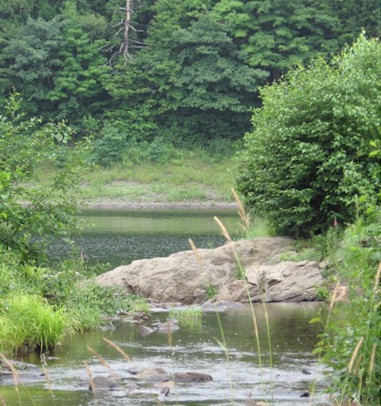Home → Water Quality → Programs → SWUP → Ch. 587 Q&A
Chapter 587 - Q&A

The In-stream Flows and Lake and Pond Water Levels rule, Chapter 587 (Word) establishes river and stream flows and lake and pond water levels to protect natural aquatic life and other designated uses in Maine 's waters. The rule applies to direct or indirect withdrawal, removal, diversion or other activity or use that alters the natural flow or water levels of a non-tidal fresh surface water of the state. These waters include rivers, streams, brooks, lakes and ponds that are classified state waters.
Who must comply with the rule?
To determine if your activity has the potential to alter flows or water levels, you may compare the size of your withdrawal with the Threshold volumes for reporting of 38 M.R.S.A. section 470-B. These thresholds start at 20,000 gallons in one day for a river, stream or brook, and 30,000 gallons in one week for lakes and ponds and increase with the size of the affected resource. If your withdrawal is below these thresholds it is presumed to be an insignificant withdrawal. The new rule also specifically exempts certain withdrawals, such as those for public emergency, and withdrawals from man-made storage ponds provided they are constructed outside of a stream channel.
Options for complying with the rule
If you have the potential to impact water levels or flows through your activities there are several ways to assure that you comply with the rule. The rule provides a standard allowable alteration for each classification of waters, which allows withdrawals without any further regulatory involvement. If you cannot operate within the standard alteration you may request an alternative flow or water level through a process outlined in the rule. To begin the process, submit a written request to commence a flow or water level planning process to the staff contact listed below. DEP staff will assist you in this process.
If you are proposing an activity which also requires a permit from the DEP, such as a Natural Resources Protection Act or Site Location of Development permit, or a permit from the Land Use Regulation Commission, the flow or water level issue will be dealt with through that permit process. If you had an existing permit on August 24, 2007, which sets a flow or water level, those flows or water levels are effective for the term of the permit. Hydropower flows and water levels will continue to be handled through the existing water quality certification process and are unaffected by the new rules.
Agricultural Producers
If you are an agricultural producer with a history of agricultural water use you have five years to attain compliance with the flow and water level requirements of the rule. If you are proposing a new withdrawal it will be required to comply with the rule. Contact the Maine Agricultural Water Management Board at the Department of Agriculture, Food and Rural Resources, Market and Production Development Division for further information, at 287-3491. www.maine.gov/agriculture/mpd/business/irrigation/
Community Water Systems
Existing Community Water Systems are allowed five years to attain compliance, from the date they are notified by the Department of non-compliance with the flow and water level requirements of the rules. Existing systems may qualify for a Community Water System Withdrawal Certificate that allows existing withdrawals to continue to serve the public based on their existing system design capacity as determined by the Drinking Water Program at the Maine Department of Health and Human Services. Contact the Drinking Water Program for further information at 287-2070.
Contact
Rob Mohlar, 207-592-1439
Maine DEP
17 State House Station
Augusta , Maine 04333-0017